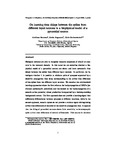On learning time delays between the spikes from different input neurons in a biophysical model of a pyramidal neuron.
| dc.contributor.author | Koutsou, A | en |
| dc.contributor.author | Bugmann, G | en |
| dc.contributor.author | Christodoulou, C | en |
| dc.date.accessioned | 2018-08-13T14:31:32Z | |
| dc.date.available | 2018-08-13T14:31:32Z | |
| dc.date.issued | 2015-10 | en |
| dc.identifier.uri | http://hdl.handle.net/10026.1/12100 | |
| dc.description.abstract |
Biological systems are able to recognise temporal sequences of stimuli or compute in the temporal domain. In this paper we are exploring whether a biophysical model of a pyramidal neuron can detect and learn systematic time delays between the spikes from different input neurons. In particular, we investigate whether it is possible to reinforce pairs of synapses separated by a dendritic propagation time delay corresponding to the arrival time difference of two spikes from two different input neurons. We examine two subthreshold learning approaches where the first relies on the backpropagation of EPSPs (excitatory postsynaptic potentials) and the second on the backpropagation of a somatic action potential, whose production is supported by a learning-enabling background current. The first approach does not provide a learning signal that sufficiently differentiates between synapses at different locations, while in the second approach, somatic spikes do not provide a reliable signal distinguishing arrival time differences of the order of the dendritic propagation time. It appears that the firing of pyramidal neurons shows little sensitivity to heterosynaptic spike arrival time differences of several milliseconds. This neuron is therefore unlikely to be able to learn to detect such differences. | en |
| dc.format.extent | 80 - 89 | en |
| dc.language | eng | en |
| dc.language.iso | eng | en |
| dc.subject | Coincidence detection | en |
| dc.subject | Dendritic propagation delays | en |
| dc.subject | Membrane noise | en |
| dc.subject | Synaptic scaling | en |
| dc.subject | Adaptation, Physiological | en |
| dc.subject | Animals | en |
| dc.subject | Computer Simulation | en |
| dc.subject | Humans | en |
| dc.subject | Learning | en |
| dc.subject | Models, Neurological | en |
| dc.subject | Nerve Net | en |
| dc.subject | Neuronal Plasticity | en |
| dc.subject | Pyramidal Cells | en |
| dc.subject | Synaptic Transmission | en |
| dc.subject | Time Factors | en |
| dc.subject | Time Perception | en |
| dc.title | On learning time delays between the spikes from different input neurons in a biophysical model of a pyramidal neuron. | en |
| dc.type | Journal Article | |
| plymouth.author-url | https://www.ncbi.nlm.nih.gov/pubmed/26341613 | en |
| plymouth.volume | 136 | en |
| plymouth.publication-status | Published | en |
| plymouth.journal | Biosystems | en |
| dc.identifier.doi | 10.1016/j.biosystems.2015.08.005 | en |
| plymouth.organisational-group | /Plymouth | |
| plymouth.organisational-group | /Plymouth/Faculty of Science and Engineering | |
| plymouth.organisational-group | /Plymouth/Research Groups | |
| plymouth.organisational-group | /Plymouth/Research Groups/Marine Institute | |
| plymouth.organisational-group | /Plymouth/Users by role | |
| dc.publisher.place | Ireland | en |
| dcterms.dateAccepted | 2015-08-22 | en |
| dc.identifier.eissn | 1872-8324 | en |
| dc.rights.embargoperiod | Not known | en |
| rioxxterms.versionofrecord | 10.1016/j.biosystems.2015.08.005 | en |
| rioxxterms.licenseref.uri | http://www.rioxx.net/licenses/all-rights-reserved | en |
| rioxxterms.licenseref.startdate | 2015-10 | en |
| rioxxterms.type | Journal Article/Review | en |


